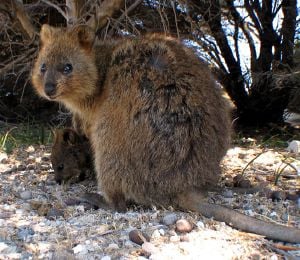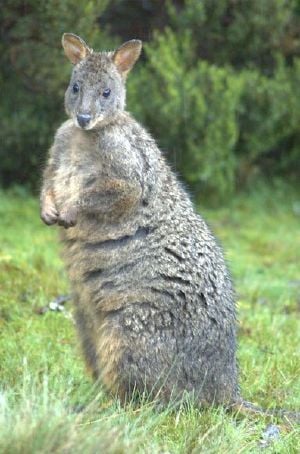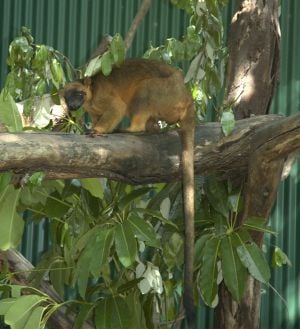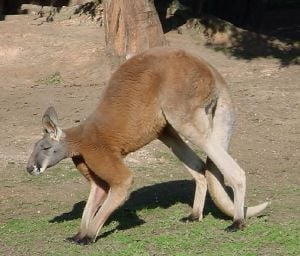Macropod
| Macropods
| ||||||||||||||
|---|---|---|---|---|---|---|---|---|---|---|---|---|---|---|
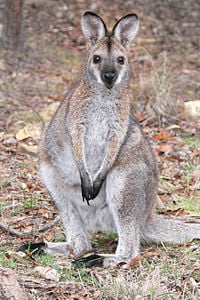 Red-necked wallaby
| ||||||||||||||
| Scientific classification | ||||||||||||||
| ||||||||||||||
|
Macropod is the common name for any of the terrestrial and arboreal marsupials comprising the mammalian family Macropodidae, characterized by strongly developed hind legs, long tails, thin necks, relatively small heads, generally prominent ears, and a predominantly herbivorous feeding behavior. There are more than 60 extant species of macropods placed in 11 genera, including the kangaroos, wallabies, tree-kangaroos, pademelons, and several others. Macropods are largely found in Australia, New Guinea, and several Indonesian islands.
In Australia, macropods were the main animal group exploited as a food resource, but also were considered "partners" in the land and were featured prominently in their culture and dreamtime stories. European settlers also used them for food and for hides. Eventually, many macropods became considered as pests that competed with the livestock and even today they are heavily hunted, whether as pests or for commercial harvesting. Six species have become extinct after European settlement and some species went extinct after the Australian Aborigines arrived and before Europeans arrived. While many species maintain healthy numbers, today one species is considered critically endangered, while seven are endangered, and about 18 are vulnerable for near threatened. The primary causes of declines are loss of habitat, competition with introduced and domestic species, and predation from introduced carnivores (cat and red fox) (Lundie-Jenkins 2004).
Overview and description
Macropods belong to the marsupial order Diprotodontia, a large and diverse group that includes, in addition to the macropods, the koalas, wombats, and possums. The family Macropodidae belongs to the suborder Phalangerida, with the possums and gliders, while the wombats and koala belong to the suborder Vombatiformes.
Macropods are further divided into two subfamilies, the Sthenurinae and the Macropodinae. While the Sthenurinae was a successful group in the Pleistocene, it now has only one extant species, the banded hare-wallaby (Lagostrophus fasciatus). All other extant macropods belong to the subfamily Macropodinae (Lundie-Jenkins 2004).
Physical description
Macropods have very large hind legs that make the upper body and forelimbs look small, relatively thin necks, and a long, powerfully muscled tail. All have relatively small heads and most have large ears, except for tree-kangaroos, which must move quickly between tight branches.
The term macropod comes from the Greek for "long foot" or "big foot" and it refers to the fact that most macropods have a very long, narrow hind foot. This enables the kangaroos, wallabies, and tree kangaroos to have a characteristic hopping gait, with the kangaroos the largest mammals to hop on both feet (Lundie-Jenkins 2004). The hind feet have a distinctive arrangement of toes: the fourth toe is very large and strong, the fifth toe moderately so, the second and third are fused, and the first toe is usually missing. The short front legs have five separate digits. Some macropods have 7 carpal bones instead of the usual 8 in mammals.
Macropods vary in size considerably. The adult hare-wallabies weigh only about 1.4 kilograms (3 pounds) and have a head-body length of 290 millimeters (11 inches), while the large gray kangaroos weight up to 85 kilograms (187 pounds) and have a head-body length of up to 2300 millimeters (91 inches) (Lundie-Jenkins 2004). There also is a large range of colors, from sandy red through black, as well as intermediate colors and mixes, and some with distinct markings, such as stripes, patches, and so forth (Lundie-Jenkins 2004).
The unusual development of the hind legs is optimized for economical long distance travel at fairly high speed. The greatly elongated feet provide enormous leverage for the strong legs. But there is more to the famous kangaroo hop: Kangaroos and wallabies have a unique ability to store elastic strain energy in their tendons. In consequence, most of the energy required for each hop is provided "free" by the spring action of the tendons (rather than by muscular effort). The main limitation on a macropod's ability to leap is not the strength of the muscles in the hindquarters. It is the ability of the joints and tendons to withstand the strain of hopping.
In addition, there is a linkage between the hopping action and breathing. As the feet leave the ground, air is expelled from the lungs by what amounts to an internal piston. Bringing the feet forward ready for landing fills the lungs again, providing further energy efficiency. Studies of kangaroos and wallabies have demonstrated that, beyond the minimum energy expenditure required to hop at all, increased speed requires very little extra effort (much less than the same speed increase in, say, a horse, a dog, or a human), and also that little extra energy is required to carry extra weight—something that is of obvious importance to females carrying large young in their pouches.
In general, macropods have a broad, straight row of cutting teeth at the front of the mouth, no canine teeth, and a gap before the molars. The molars are large and, unusually, do not appear all at once but a pair at a time at the back of the mouth as the animal ages, eventually becoming worn down by the tough, abrasive grasses and falling out. Most species have four molars and, when the last pair is too worn to be of use, they starve. The dental formula for macropods is:
| Dentition |
|---|
| 3.0-1.2.4 |
| 1.0.2.4 |
Like the eutherian ruminants of the northern hemisphere (sheep, cattle, and so on), macropods have specialized digestive systems that use a high concentration of bacteria, protozoans, and fungi in the first chamber of a complex stomach to digest plant material. The details of organization are quite different, but the end result is somewhat similar.
Behavior, feeding ecology, and reproduction
While kangaroos and wallabies are terrestrial, the tree-kangaroos are arboreal, being adapted for life in trees, but slow and clumsy on the ground. on the ground, they move at about walking pace and hop awkwardly, leaning their body far forward to balance the heavy tail. But in trees they are bold and agile. They climb by wrapping the forelimbs around the trunk of a tree and hopping with the powerful hind legs, allowing the forelimbs to slide.
Macropods are predominately herbivorous, but some species will eat invertebrates and fungi (Lundie-Jenkins 2004). While some macropods are browsers, most are grazers and are equipped with appropriately specialized teeth for cropping and grinding up fibrous plants, in particular grasses and sedges. Smaller species tend to seek out seeds, fruits, actively growing plants and other high-quality food items, while larger kangaroos can process lower=quality food items and consume a large variety of plants (Lundie-Jenkins 2004).
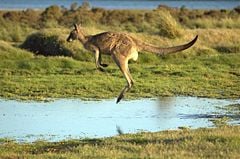
Small, selective feeders tend to be dispersed and solitary, while larger grazers tend to be gregarious, including some larger species that form groups ("mobs") of 50 or more animals (Lundie-Jenkins 2004).
Macropods are promiscuous in mating system. Gestation in macropods lasts about a month, being slightly longer in the largest species. Typically, only a single young is born, weighing less than a gram at birth. They soon attach themselves to one of four teats inside the mother's pouch. The young leave the pouch after 5-11 months, and are weaned after a further 2-6 months. Macropods commonly reach sexual maturity at one to three years of age, but it depending on species (Poole 1984). However, while the larger kangaroos species may breed at two to three years, in some of the smaller species the females cna conceive at or slightly before weaning at four to five months (Lundie-Jenkins 2004). The young are born very small and the pouch opens forward.
The ability of larger macropods to survive on poor-quality, low-energy feed, and to travel long distances at high speed without great energy expenditure (to reach fresh food supplies or waterholes, and to escape predators) has been crucial to their evolutionary success on a continent that, because of soil fertility and low, unpredictable average rainfall, offers only very limited primary plant productivity.
Classification
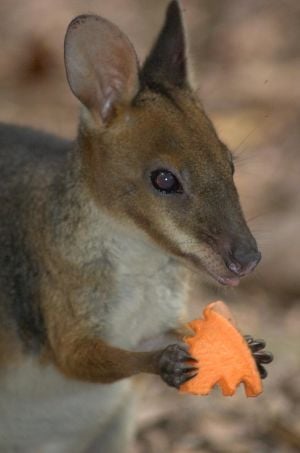
There are two subfamilies in the Macropodidae family: the Sthenurinae was highly successful in the Pleistocene but is now represented by just a single species, and a vulnerable one at that, the [bBanded hare-wallaby]]; the remainder, about 60 species, makes up the subfamily Macropodinae.
A number of extinct species have been discovered. The earliest known fossil macropod dates back about 11.61 million years ago (mya) to 28.4 mya, either in the Miocene or Late Oligocene, and was uncovered in South Australia. Unfortunately, the fossil could not be identified any further than the family. A Queensland fossil of a species similar to Hadronomas has been dated at around 5.33 mya to 11.61 mya, falling in the Late Miocene or Early Pliocene. The earliest completely identifiable fossils are from around 5.33 mya.
The following taxonomy was drawn from Haaramo (2004), with "†" symbolizing extinct taxa.
- FAMILY MACROPODIDAE (Haaramo 2007)
- Genus †Watutia
- Genus †Dorcopsoides
- Genus †Kurrabi
- Subfamily Sthenurinae
- Genus †Hadronomas
- Genus †Eosthenurus
- Genus †Sthenurus
- Genus †Procoptodon
- Genus †Nambaroo
- Genus †Wururoo
- Genus †Ganawamaya
- Genus †Balbaroo
- Genus †Silvaroo
- Genus Lagostrophus
- Banded Hare-wallaby, Lagostrophus fasciatus
- Subfamily Macropodinae
- Genus †Prionotemnus
- Genus †Congruus
- Genus †Baringa
- Genus †Bohra
- Genus †Synaptodon
- Genus †Fissuridon
- Genus †Protemnodon
- Genus †Troposodon
- Genus Dendrolagus: tree-kangaroos
- Grizzled tree-kangaroo, Dendrolagus inustus
- Lumholtz's tree-kangaroo, Dendrolagus lumholtzi
- Bennett's tree-kangaroo, Dendrolagus bennettianus
- Ursine tree-kangaroo, Dendrolagus ursinus
- Matschie's tree-kangaroo, Dendrolagus matschiei
- Doria's tree-kangaroo, Dendrolagus dorianus
- Goodfellow’s tree-kangaroo, Dendrolagus goodfellowi
- Lowlands tree-kangaroo, Dendrolagus spadix
- Golden-mantled tree-kangaroo, Dendrolagus pulcherrimus
- Seri's tree-kangaroo, Dendrolagus stellarum
- Dingiso, Dendrolagus mbaiso
- Tenkile, Dendrolagus scottae
- Genus Dorcopsis
- Brown dorcopsis, Dorcopsis muelleri
- White-striped dorcopsis, Dorcopsis hageni
- Black dorcopsis, Dorcopsis atrata
- Gray dorcopsis, Dorcopsis luctuosa
- Genus Dorcopsulus
- Small dorcopsis, Dorcopsulus vanheurni
- Macleay's orcopsis, Dorcopsulus macleayi
- Genus Lagorchestes
- †Lake Mackay hare-wallaby, †Lagorchestes asomatus
- Spectacled hare-wallaby, Lagorchestes conspicillatus
- Rufous hare-wallaby, Lagorchestes hirsutus
- †Eastern hare-wallaby, †Lagorchestes leporides
- Genus Macropus
- Subgenus Notamacropus
- Agile wallaby, Macropus agilis
- Black-striped wallaby, Macropus dorsalis
- Tammar wallaby, Macropus eugenii
- †Toolache wallaby, †Macropus greyii
- Western brush wallaby, Macropus irma
- Parma wallaby, Macropus parma (rediscovered, thought extinct for 100 years)
- Pretty-faced wallaby, Macropus parryi
- Red-necked wallaby, Macropus rufogriseus
- Subgenus Osphranter
- Antilopine kangaroo, Macropus antilopinus
- Woodward's wallaroo, Macropus bernadus
- Eastern wallaroo, Macropus robustus
- Red kangaroo, Macropus rufus
- Subgenus Macropus
- Western gray kangaroo, Macropus fuliginosus
- Eastern gray kangaroo, Macropus giganteus
- Subgenus Notamacropus
- Genus Onychogalea
- Bridled nail-tail wallaby, Onychogalea fraenata
- †Crescent nail-tail wallaby, †Onychogalea lunata
- Northern nail-tail wallaby, Onychogalea unguifera
- Genus Petrogale
- P. brachyotis species-group
- Short-eared rock-wallaby, Petrogale brachyotis
- Monjon, Petrogale burbidgei
- Nabarlek, Petrogale concinna
- P. xanthopus species-group
- Proserpine rock-wallaby, Petrogale persephone
- Rothschild's rock-wallaby, Petrogale rothschildi
- Yellow-footed rock-wallaby, Petrogale xanthopus
- P. lateralis/penicillata species-group
- Allied rock-wallaby, Petrogale assimilis
- Cape York rock-wallaby, Petrogale coenensis
- Godman's rock-wallaby, Petrogale godmani
- Herbert's rock-wallaby, Petrogale herberti
- Unadorned rock-wallaby, Petrogale inornata
- Black-flanked rock-wallaby, Petrogale lateralis
- Mareeba rock-wallaby, Petrogale mareeba
- Brush-tailed rock-wallaby, Petrogale penicillata
- Purple-necked rock-wallaby, Petrogale purpureicollis
- Mt. Claro rock-wallaby, Petrogale sharmani
- P. brachyotis species-group
- Genus Setonix
- Quokka: Setonix brachyurus
- Genus Thylogale
- Tasmanian pademelon, Thylogale billardierii
- Brown's pademelon, Thylogale browni
- Dusky pademelon, Thylogale brunii
- Calaby's pademelon, Thylogale calabyi
- Mountain pademelon, Thylogale lanatus
- Red-legged pademelon, Thylogale stigmatica
- Red-necked pademelon, Thylogale thetis
- Genus Wallabia
- Swamp wallaby or black wallaby, Wallabia bicolor
ReferencesISBN links support NWE through referral fees
- Groves, C. 2005. Macropodidae. Pages 58-70 in D. E. Wilson, and D. M. Reeder (eds.), Mammal Species of the World, 3rd edition. Johns Hopkins University Press. ISBN 0801882214.
- Haaramo, M. 2007. Macropodidae. Mikko's Phylogeny Archive. Retrieved November 9, 2008.
- Lundie-Jenkins, G. 2004. Macropodidae. In B. Grzimek, D. G. Kleiman, V. Geist, and M. C. McDade, Grzimek's Animal Life Encyclopedia. Detroit: Thomson-Gale, 2004. ISBN 0307394913.
- Poole, W. E. 1984. Macropodidae. Pages 862-871 in D. Macdonald, The Encyclopedia of Mammals. New York: Facts on File. ISBN 0871968711.
Credits
New World Encyclopedia writers and editors rewrote and completed the Wikipedia article in accordance with New World Encyclopedia standards. This article abides by terms of the Creative Commons CC-by-sa 3.0 License (CC-by-sa), which may be used and disseminated with proper attribution. Credit is due under the terms of this license that can reference both the New World Encyclopedia contributors and the selfless volunteer contributors of the Wikimedia Foundation. To cite this article click here for a list of acceptable citing formats.The history of earlier contributions by wikipedians is accessible to researchers here:
The history of this article since it was imported to New World Encyclopedia:
Note: Some restrictions may apply to use of individual images which are separately licensed.
